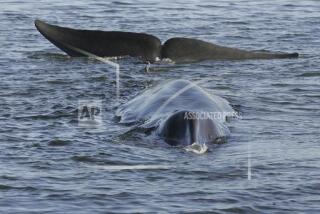Icelanders Are Taking Strong Beer Freedom Soberly
- Share via
REYKJAVIK, Iceland — The doom-sayers had said that allowing hard-working Icelanders to drink strong beer would turn them into lazy, round-the-clock drunks.
But since “B-Day” on March 1, when strong beer flowed legally for the first time in 74 years, the police have reported no increase in drunk driving, and bar owners say people still restrict their hard drinking to weekends.
“Icelanders are happier and less drunk,” said Gudrun Helgadottir, president of the Althing (parliament) and a sponsor of the legislation legalizing beer with alcoholic content above 2.25%.
Anti-alcohol campaigners, however, report backsliding by some recovered alcoholics and worry about more imbibing in general, especially among the young.
‘B-Day’ Celebrations
“B-Day” was celebrated with parties, pub openings and even a few free drinks, and although strong beer is expensive, it is now the favorite alcoholic beverage in this North Atlantic island nation of 250,000.
In the first month, Icelanders consumed nearly 1.3 million quarts of beer--about 5.1 quarts for every man, woman and child.
Hoskuldur Jonsson, general manager of the State Wine, Spirit and Tobacco Authority, said once the novelty wore off, beer consumption dropped to between 635,000 and 690,000 quarts a month.
“The wave went over and we are now sailing on a rather calm sea,” Jonsson said.
Olafur Arnason, director of the state-funded Liquor Prevention Council of Iceland, said alcohol sales rose 25% in the first three months of 1989 and that state institutions for alcoholics are reporting more admissions of former alcoholics who had been sober for several years.
To combat an increase in drinking by 18- to 20-year-olds, the council has put out an advertisement showing a cartoon of a young person with no head.
“God gave you intelligence; don’t drink it away,” it says.
Until March 1, Icelanders could drink whiskey, vodka, wine, low-alcohol beer or Brennivin, the national strong spirit also called “Black Death.” But they could not legally buy strong beer except at airport duty-free stores.
Iceland ended 25 years of prohibition in 1933, but a legal quirk kept all but the weakest beers banned. A powerful temperance lobby kept it that way until May, 1988, when the Althing lifted the prohibition.
Foes’ Argument
“The argument of opponents was that beer would increase the consumption of Icelanders and they’d be drunk all day,” Helgadottir said.
“What we’ve seen is that the sale of strong spirits has fallen . . . and the police are very happy. There is less fighting on the streets on Friday and Saturday, less violence as a whole.”
Jonsson said consumption of white wine fell by 30% in March, and strong spirits, especially white spirits like vodka, by 10%.
“I worried if we would have the same attitude to beer--drinking during working hours--as they do in Germany and Denmark,” he said.
That has not happened, he added, and “some police tell me it’s easier to deal with people who drink beer than strong spirits because they are less violent or more sleepy, or not as quick in their reactions.”
Another positive effect, he said, has been the collapse of the thriving black market in smuggled beer, which is equally expensive.
A glass in a bar costs $3.40 to $4.20. A six-pack in the state liquor stores costs $10.50 to $11.90. The top seller is West Germany’s Lowenbrau, brewed here under license.
Oskar Sveinsson, a waiter at Iceland’s oldest pub, Gaukur a Stong, said up to 60% of sales are beer. But he added: “People have found that if they drink a lot of beer, they get a lot of headaches . . . so if they are going to get drunk, they drink something else, mainly vodka.”
Chuck Fleenor of Bluefield, W. Va., who worked behind the bar at the Duus-Hus pub on “B-Day,” said: “I think people have become more mellow now. Before, they were drinking harder whiskey and things would get a little rowdy on weekends.”
More to Read
Sign up for Essential California
The most important California stories and recommendations in your inbox every morning.
You may occasionally receive promotional content from the Los Angeles Times.













